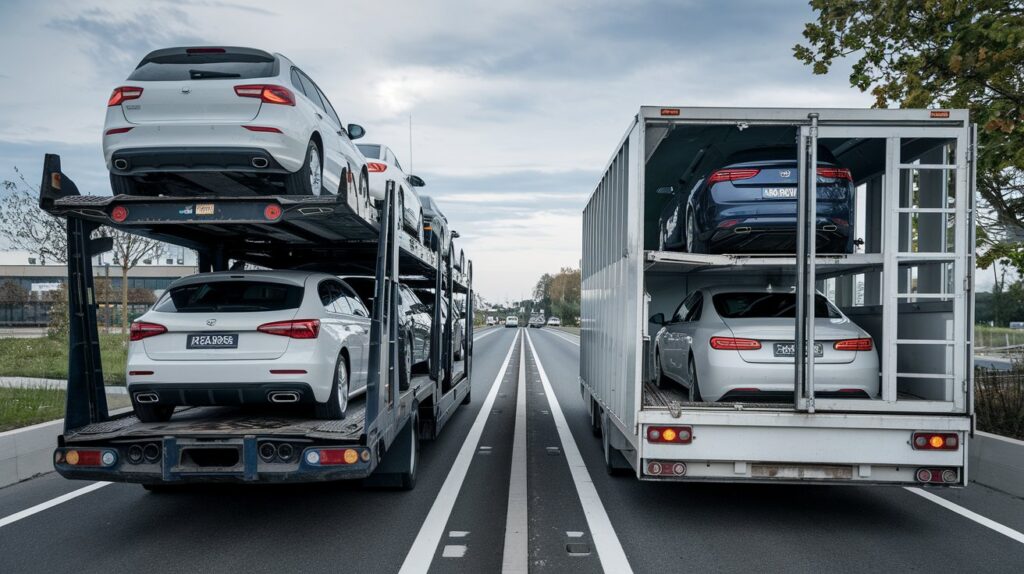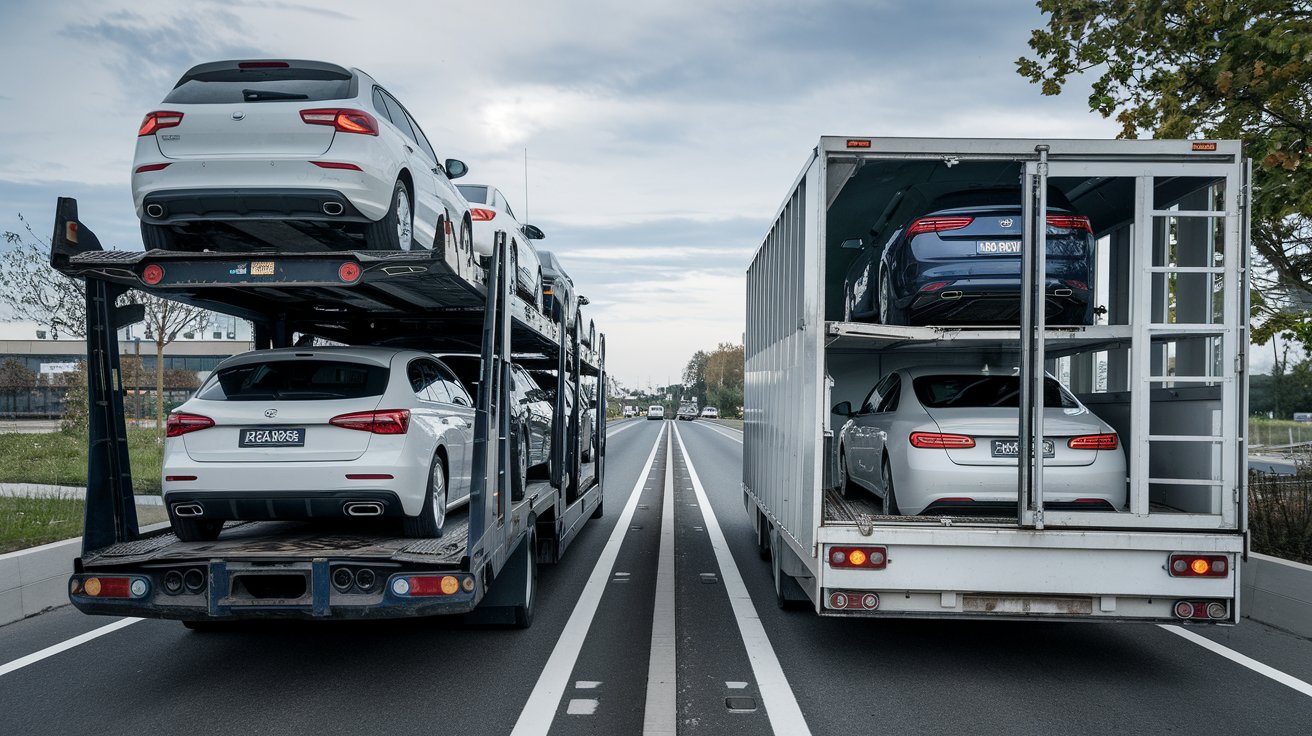Are you planning to transport your vehicle across the country or just down the street? The first question that pops up is: should you go with open car transport or opt for an enclosed carrier? This decision can feel overwhelming, but fear not! In this comprehensive guide, we’ll unravel the mystery behind both options and help you make an informed choice tailored to your needs. Whether you’re shipping a classic car that deserves extra protection or simply moving a reliable sedan, understanding the pros and cons of each method will ensure your vehicle arrives safely and in style. Buckle up as we navigate through everything you need to know about open versus enclosed car transport!

Introduction to Open and Enclosed Car Transport
Transporting your vehicle can feel like a daunting task. With so many options available, how do you choose the right method for your needs? Open and enclosed car transport are two popular choices that cater to different requirements and preferences. Whether you’re moving across the country or just need to ship a classic car, understanding these options is essential for making an informed decision. Let’s dive into the world of open and enclosed car transport, exploring their features, benefits, and factors to consider before making that final choice. Your vehicle deserves the best care during transit—let’s find out which option suits it best!
What is Open Car Transport?
Open car transport refers to a method of shipping vehicles using an open trailer. This type of transport exposes the vehicle to the elements during transit, as there is no protective coverage.
Typically, multiple cars are loaded onto a single truck for efficiency. The trailers can accommodate various sizes and shapes, making it a flexible choice for many situations.
Despite its exposure, open car transport often comes with advantages such as lower costs and quicker delivery times. It’s ideal for standard vehicles that don’t require special handling or protection.
However, potential downsides include susceptibility to weather conditions and road debris. Car owners who prioritize budget over protection might prefer this option but should weigh these factors carefully before deciding.
– Definition
Open car transport is a vehicle shipping method where cars are transported on an open trailer. This cost-effective option is widely used by dealerships and individual owners alike.
- Multiple Vehicle Capacity: Open trailers can carry several cars at once, making the process efficient and economical, especially for bulk transportation.
- Exposure to Weather: Vehicles are exposed to rain, dust, and sunlight during transit. However, this is generally safe for standard cars, as they are built to withstand regular weather conditions.
- Faster and More Convenient: Open transport is often quicker to schedule due to the higher availability of carriers, making it a preferred option for time-sensitive shipments.
- Cost-Effective Solution: It is a budget-friendly choice, making it ideal for regular vehicles, fleet transport, and relocation needs.
While it offers less protection than enclosed transport, open car transport remains a reliable, efficient, and practical option for most vehicle owners.
– How it works
Open car transport operates on a simple yet efficient principle. Cars are loaded onto an open trailer, often alongside other vehicles. This method is commonly used for transporting many cars at once. Once the vehicle is secured, it enters the journey to its destination. The open trailers provide easy access for loading and unloading, making the process quick and straightforward.
While most cars can be transported this way, special attention should be given to fragile or high-value vehicles during transit. Because they are exposed to the elements, these cars may face risks such as dirt and debris.
Transport companies typically track shipments throughout their journey. Clients receive updates about location and estimated arrival times. All in all, open car transport represents a practical choice for many vehicle owners looking for efficiency without breaking the bank.
– Pros and Cons
When weighing the pros of open car transport, affordability tops the list. It’s generally cheaper due to its high capacity and quicker loading times. Additionally, it allows for a faster delivery process since more vehicles can be transported at once.
However, exposure is a significant downside. Vehicles in open transport face harsh weather conditions and road debris, which can lead to potential damages.
On the other hand, enclosed car transport offers superior protection. Enclosed carriers shield your vehicle from elements like rain or snow and minimize risks from road hazards. This option is ideal for luxury or classic cars that require extra care.
Yet, this protection comes with a price tag—enclosed transport typically costs more than its open counterpart. Moreover, availability may vary based on location and demand, potentially leading to longer wait times for pickup or delivery.
What is Enclosed Car Transport?
Enclosed car transport refers to a method of shipping vehicles within a fully enclosed trailer. This approach offers an extra layer of protection against the elements and road debris.
In this setup, cars are secured inside a specially designed carrier. The enclosed structure shields them from rain, snow, dirt, and UV rays. This is particularly beneficial for luxury or vintage vehicles that need careful handling.
Transport companies typically use larger trailers equipped with hydraulic lifts for easy loading and unloading. This ensures your vehicle remains safe throughout its journey.
While it may take slightly longer compared to open transport due to limited availability, many opt for this option when security is paramount. The peace of mind knowing your vehicle is insulated from potential damage makes all the difference during transportation.
– Pros and Cons
Open Car Transport – Pros:
- More Affordable: Open transport is generally cheaper, making it a budget-friendly option.
- Efficient Loading and Unloading: The open structure allows for quicker loading and unloading, reducing overall transit time.
- Widespread Availability: Open carriers are more common, offering flexible scheduling and faster service.
Open Car Transport – Cons:
- Exposure to Elements: Vehicles are vulnerable to weather conditions such as rain, snow, and dust.
- Potential for Minor Debris Damage: Cars may encounter road debris, which could cause minor scratches or dents.
- Less Security: Offers minimal protection, making it less suitable for high-value or classic cars.
Enclosed Car Transport – Pros:
- Superior Protection: Vehicles are shielded from weather, dust, and road debris, ensuring they arrive in pristine condition.
- Ideal for Luxury and Classic Cars: Provides extra security for high-value or collectible vehicles.
- Reduced Risk of Damage: Enclosed carriers minimize the chances of external damage.
Enclosed Car Transport – Cons:
- Higher Cost: Enclosed transport is significantly more expensive due to its added protection.
- Limited Availability: Fewer enclosed carriers means longer wait times and less flexibility.
- Slower Delivery: Loading and unloading may take longer, extending the overall transit time.
– Distance of transport
The distance of transport plays a significant role in determining the best option between open and enclosed car transport. For short distances, open transport can be an efficient choice. It typically involves quicker turnaround times and is often more economical.
When dealing with longer distances, factors such as weather conditions and road hazards come into play. Enclosed car transport provides added protection over extended journeys. This can safeguard your vehicle from potential damage caused by debris or harsh elements.
Consider also the frequency of stops along the route. Open carriers may have multiple pickups and drop-offs, while enclosed options tend to have a more direct path to their destination.
Ultimately, weighing these considerations will help you decide which method aligns better with your transportation needs based on how far your vehicle must travel.
– Type of vehicle being transported
The type of vehicle being transported plays a crucial role in your decision between open and enclosed car transport. High-end luxury cars, classic models, or exotic vehicles often require extra protection during transit.
Enclosed car transport offers a secure environment for these valuable assets. The added layer of security shields them from weather conditions, road debris, and potential damage.
On the other hand, standard sedans or everyday vehicles can typically fare well in an open trailer setting. Many owners opt for this method due to its cost-effectiveness and availability.
However, consider factors like mileage and wear-and-tear on the vehicle. If you’re moving a vintage car with sentimental value or rare features, investing in enclosed transport is worth every penny to ensure it arrives safely at its destination.
– Time sensitivity
Time sensitivity plays a crucial role when selecting between open and enclosed car transport. If you need your vehicle delivered quickly, the choice of transport method can impact delivery times.
Open car transport often allows for faster shipping. With multiple vehicles loaded onto one carrier, these transports have more frequent trips, ensuring speedier service.
On the other hand, enclosed car transport may take longer due to limited availability and scheduling. Enclosed carriers usually haul fewer cars at once, making them less flexible in terms of timing.
If you’re dealing with tight deadlines, it’s essential to discuss your timeline with the transport company upfront. They can provide realistic estimates based on their current capacity and routes.
Ultimately, understanding how time sensitivity affects your choices will help ensure that your vehicle arrives exactly when you need it.
Cost Comparison Between Open and Enclosed Car Transport
When it comes to cost, open car transport generally offers a more budget-friendly option. The simplicity of this method—using an open trailer with multiple vehicles—keeps expenses lower.
Enclosed car transport tends to be pricier due to its protective features. This service is ideal for luxury or classic cars that require extra care during transit.
Factors like distance and vehicle size can influence pricing in both methods. For instance, longer distances may increase costs regardless of the chosen type.
While enclosed transport provides greater security against weather and road debris, it’s essential to weigh whether those benefits justify the price hike for your specific needs. Understanding these nuances helps you make a well-informed decision tailored to your situation.
Tips for a Successful Open or Enclosed Car Transport Experience
Preparing your vehicle for transport is essential. Ensure it’s clean and free of personal items. This makes inspections easier and protects your belongings.
Document the condition of your car before shipping. Take photos from multiple angles to have a record in case any issues arise during transit.
Communicate openly with the transport company. Provide them with all necessary details about your vehicle, including its size, weight, and any modifications that might affect loading or unloading.
Timing is key. Schedule your transport well in advance to avoid last-minute stress. Keep track of the estimated delivery dates but remain flexible as delays can occur due to weather or road conditions.
Lastly, choose a reputable carrier. Read reviews and check their insurance policies to ensure you’re entrusting your car to experienced professionals who prioritize safety during enclosed car transport or open options.
Frequently Asked Questions About Open and Enclosed Car Transport
Choosing between open and enclosed car transport comes with many questions. From safety concerns to cost differences, understanding the details can help you make a confident decision. Here are some of the most common questions answered clearly and concisely. Many people have questions when it comes to open and enclosed car transport. Like:
- Safety Differences:
Open transport exposes vehicles to weather and road debris but is generally safe for standard cars. Enclosed transport offers full protection from rain, dust, and UV rays, making it ideal for high-value or classic vehicles. - Cost Comparison:
Open transport is more affordable as it carries multiple vehicles at once, lowering the per-car shipping cost. Enclosed transport is more expensive due to its added protection and limited capacity. - Delivery Time:
Open transport typically offers faster delivery since it has more frequent trips and carrier availability. Enclosed transport may take longer due to fewer carriers and lower vehicle capacity. - Insurance Coverage:
Both open and enclosed transport services include basic insurance during transit. It’s important to verify the coverage details with your provider before shipping. - Best Choice for Your Car:
Open transport is suitable for everyday vehicles and budget-conscious shipping. Enclosed transport is recommended for luxury, exotic, or classic cars requiring extra protection.
Understanding the key differences between open and enclosed car transport helps you choose the right option for your needs. Open transport offers a cost-effective and faster solution for standard vehicles, while enclosed transport provides added security for high-value cars. Consider your car’s value, budget, and protection requirements when making your decision.
Conclusion
Choosing the right car transport method largely depends on your individual needs and circumstances. If you’re looking for a cost-effective solution and are transporting a standard vehicle over a short distance, open car transport might be the way to go. It’s reliable and widely used.
On the other hand, if you have a luxury or classic car that requires extra protection during transit, enclosed car transport is likely your best bet. This option ensures that your vehicle is shielded from weather elements and road debris.
Consider factors such as distance, type of vehicle, and urgency when making your decision. Weighing these aspects against each type of service will guide you in selecting what works best for your situation. Both options offer distinct benefits; it’s all about prioritizing what’s most important to you in this transportation journey.


Leave a Reply